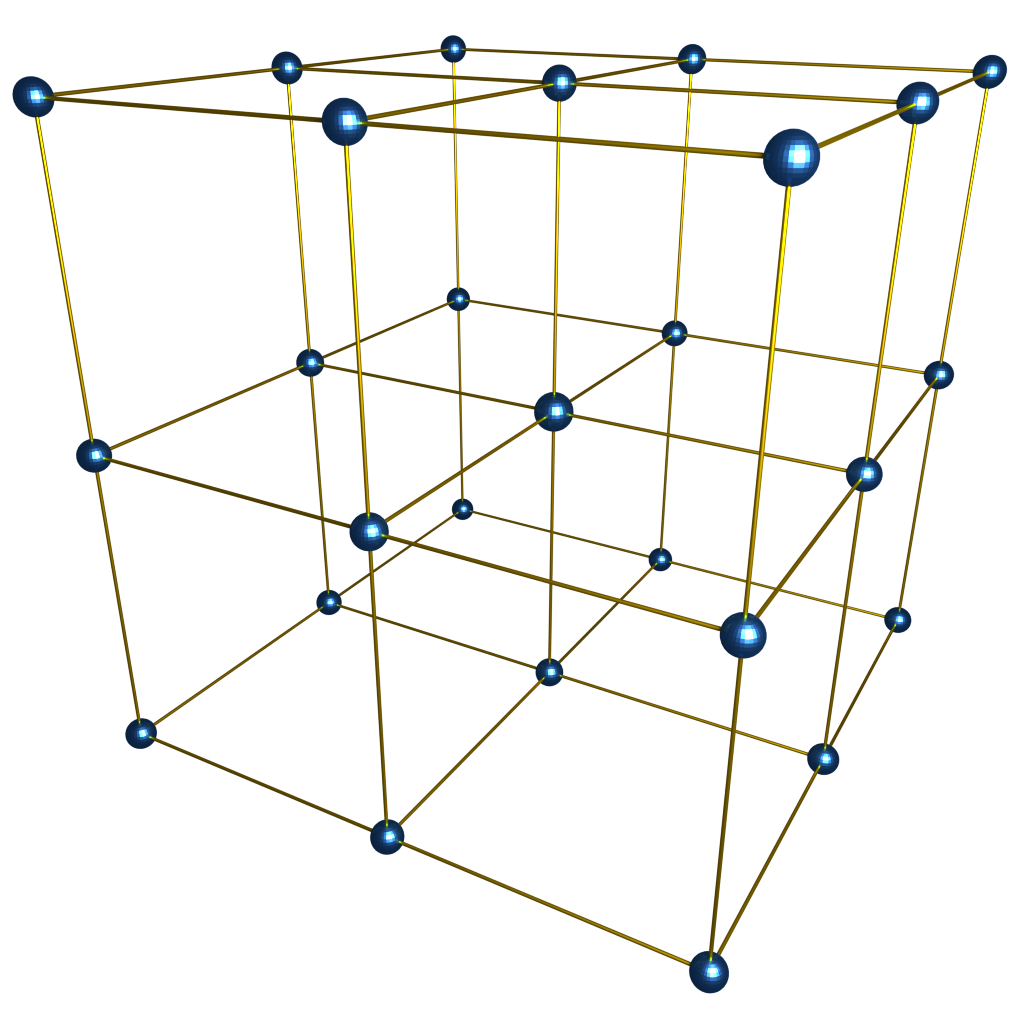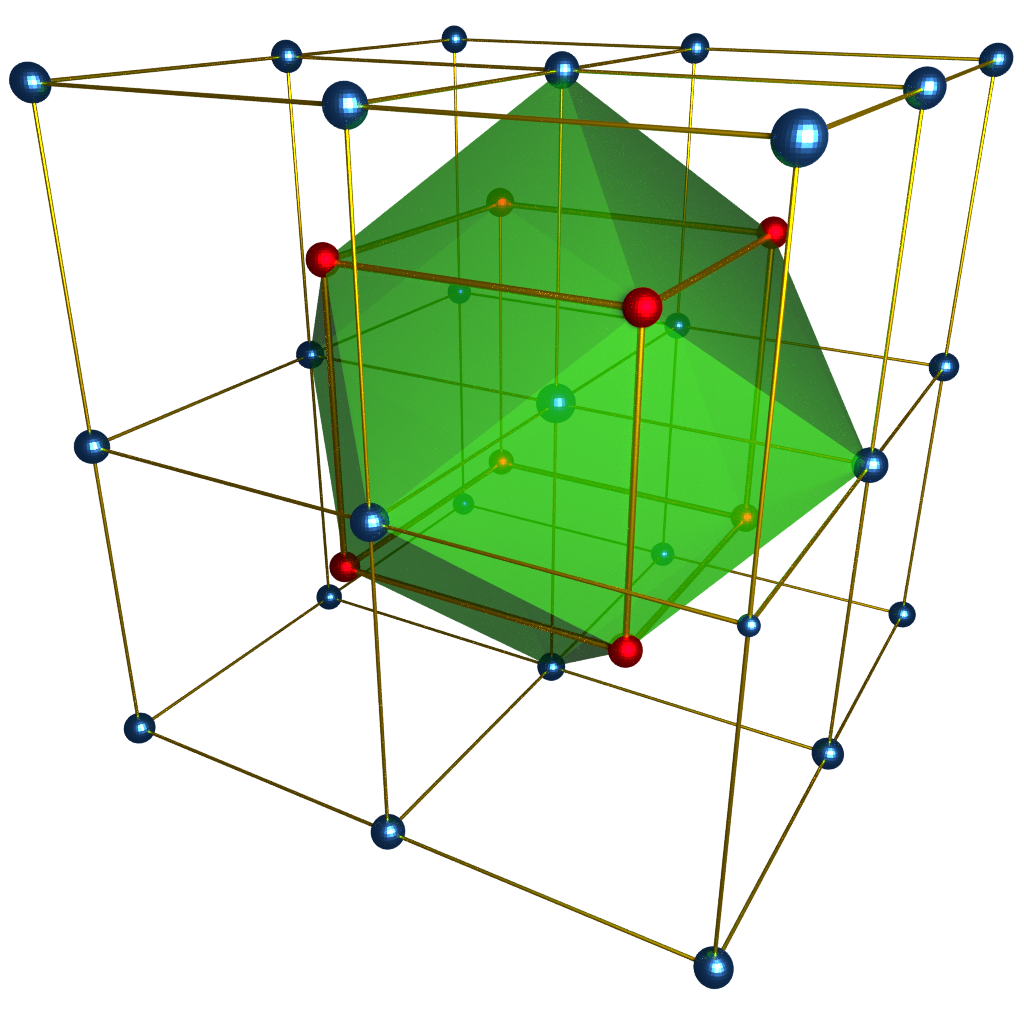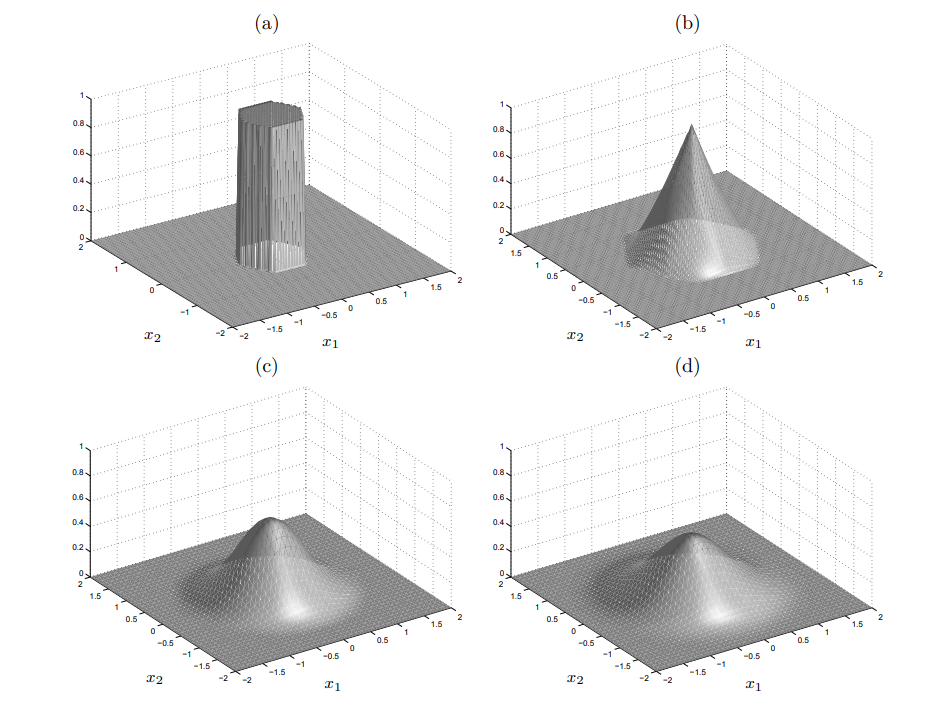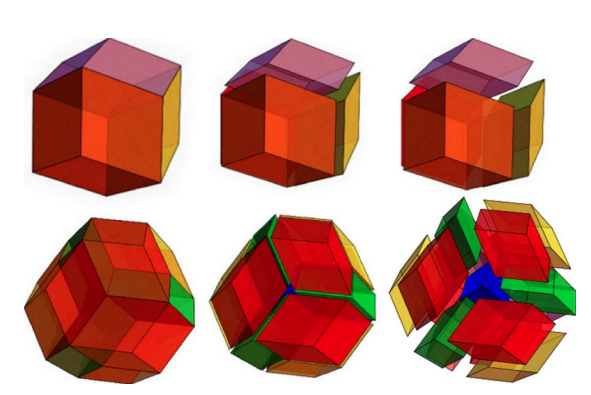Fast Spline Evaluation
Part 2: Code generation
J. Horacsek
November 20th, 2020
Where we've been...
- Box splines (Voronoi splines too)
- Approximation spaces
- Optimization (within spline spaces)
Motivation
For scalar vis, we often care about evaluating functions of the form
And we want to do this quickly (on the GPU, too); this is required for interactive visualization
Sampling Lattices
Cartesian Lattice


Body Centered Cubic Lattice
L controls the point distribution
Going fast (on the GPU)
Application dictates speed, but we can make some observations to speed up computations
- No branches in code (or at least reduce branches)
- Minimize expensive memory fetches (by organizing fetches and using trilinear fetches)
- Waste computation if necessary (the process is already bandwidth limited, it's ok to waste computation)
What about on the CPU?
Box Splines
Multivariate extension to B-splines
- Compact
- Smooth
- Piecewise polynomials
Start with a direction matrix
Box Splines
Convolutional, recursive definition
In one dimension, this looks like

Voronoi Splines

Voronoi Splines

FCC
BCC
Generic Evaluation
Lattice
Basis Function
Take this description, and ''generate code'' for it.
LLVM
A series of tools that transforms a low level representation (LLVM-IR) into functionally equivalent LLVM-IR.
What LLVM actually is, is quite vague.
....and backend code generators for various architectures.
Low level virtual machine
LLVM
Traditional compiler design is somewhat adhoc
Internal representation -> Optimization -> Code Generation
High Level Language
LLVM-IR
LLVM-IR
Optimization Passes
Front-end Compiler
Target Back-end
Machine Code
Language designers only need to focus on high level semantics.
LLVM
LLVM-IR Crash Course
LLVM feels like a low level assembly language
define i32 @mul_add(i32 %x, i32 %y, i32 %z) {
entry:
%tmp = mul i32 %x, %y
%tmp2 = add i32 %tmp, %z
ret i32 %tmp2
}Although, it looks like assembly, there is no concept of a 'register'. Single static assignment --- variables are assigned once, and it is up to the backend to do register allocation.
LLVM
LLVM-IR Crash Course
All code can be converted to SSA form, (with the addition of \(\phi\) functions.)
define i32 @mul_add(i32 %x, i32 %y, i32 %z) {
entry:
%tmp = mul i32 %x, %y
%tmp2 = add i32 %tmp, %z
ret i32 %tmp2
}Code is organized into basic blocks, control may be conditionally passed to those blocks
LLVM
LLVM-IR Crash Course
All code can be converted to SSA form, (with the addition of \(\phi\) functions.)

LLVM
LLVM-IR Crash Course
define i32 @phi_example(i32) #0 {
entry:
%cmp = icmp sgt i32 %0, 0
br i1 %cmp, label %case0, label %case1
case0:
%tmp0 = add nsw i32 %0, 1
br label %exit
case1:
%tmp1 = sub nsw i32 %0, 1
br label %exit
exit:
%result = phi i32 [%tmp0, %case0], [%tmp1, %case1]
ret i32 %result
}
LLVM
Optimization Passes
Transform LLVM-IR into (hopefully) functionally equvalent forms.
The main tool for this is opt, run opt --help for more information.
Dead code elimination, Global value numbering, fusing Instructions (you need to flag operations with fastmath for some of these) loop optimizations, etc...
LLVM
Target Backend
The tool here is llc, can specify the target backend
.text
.file "e.ll"
.globl phi_example # -- Begin function phi_example
.p2align 4, 0x90
.type phi_example,@function
phi_example: # @phi_example
.cfi_startproc
# %bb.0: # %entry
movl %edi, %eax
testl %edi, %edi
jle .LBB0_2
# %bb.1: # %case0
incl %eax
retq
.LBB0_2: # %case1
decl %eax
retq
.Lfunc_end0:
.size phi_example, .Lfunc_end0-phi_example
.cfi_endproc
# -- End function
.section ".note.GNU-stack","",@progbits
Can easily cross-compile to other architectures with -mcpu flag
LLVM
double horner_polynomial[] = {
10., 2., 4., 0., 0., 0., 0., 1.
};
double horner_eval(double x) {
double result = horner_polynomial[0];
for (int i = 1; i < sizeof(horner_polynomial) / sizeof(double); i++) {
result = result * x + horner_polynomial[i];
}
return result;
}An illustrative example, recall Horner's method
\({\displaystyle {\begin{aligned}a_{0}&+a_{1}x+a_{2}x^{2}+a_{3}x^{3}+\cdots +a_{n}x^{n}\\&=a_{0}+x{\bigg (}a_{1}+x{\Big (}a_{2}+x{\big (}a_{3}+\cdots +x(a_{n-1}+x\,a_{n})\cdots {\big )}{\Big )}{\bigg )}\,\end{aligned}}}\)
LLVM
An Example
import llvmlite.ir as ll # You'll need to install llvmlite to run this
import llvmlite.binding as llvm
llvm.initialize()
llvm.initialize_native_target()
llvm.initialize_native_asmprinter()
def build_llvm_code(horner_polynomial):
module = ll.Module()
func_ty = ll.FunctionType(ll.DoubleType(), [ll.DoubleType()])
func = ll.Function(module, func_ty, name='horner_eval')
bb = func.append_basic_block('entry')
irbuilder = ll.IRBuilder(bb)
result = ll.DoubleType()(horner_polynomial[0])
for coeff in horner_polynomial[1:]:
result = irbuilder.fmul(func.args[0], result)
if coeff != 0:
result = irbuilder.fadd(result, ll.DoubleType()(coeff))
irbuilder.ret(result)
return str(module)
build_llvm_code([10, 2, 4, 0, 0, 0, 0, 1])
LLVM
An Example
; ModuleID = ""
target triple = "x86_64-unknown-unknown"
target datalayout = ""
define double @"horner_eval"(double %".1")
{
entry:
%".3" = fmul double %".1", 0x4024000000000000
%".4" = fadd double %".3", 0x4000000000000000
%".5" = fmul double %".1", %".4"
%".6" = fadd double %".5", 0x4010000000000000
%".7" = fmul double %".1", %".6"
%".8" = fmul double %".1", %".7"
%".9" = fmul double %".1", %".8"
%".10" = fmul double %".1", %".9"
%".11" = fmul double %".1", %".10"
%".12" = fadd double %".11", 0x3ff0000000000000
ret double %".12"
}
LLVM
An Example
.text
.file "example.ll"
.section .rodata.cst8,"aM",@progbits,8
.p2align 3 # -- Begin function horner_eval
.LCPI0_0:
.quad 4621819117588971520 # double 10
.LCPI0_1:
.quad 4611686018427387904 # double 2
.LCPI0_2:
.quad 4616189618054758400 # double 4
.LCPI0_3:
.quad 4607182418800017408 # double 1
.text
.globl horner_eval
.p2align 4, 0x90
.type horner_eval,@function
horner_eval: # @horner_eval
.cfi_startproc
# %bb.0: # %entry
movsd .LCPI0_0(%rip), %xmm1 # xmm1 = mem[0],zero
mulsd %xmm0, %xmm1
addsd .LCPI0_1(%rip), %xmm1
mulsd %xmm0, %xmm1
addsd .LCPI0_2(%rip), %xmm1
mulsd %xmm0, %xmm1
mulsd %xmm0, %xmm1
mulsd %xmm0, %xmm1
mulsd %xmm0, %xmm1
mulsd %xmm1, %xmm0
addsd .LCPI0_3(%rip), %xmm0
retq
.Lfunc_end0:
.size horner_eval, .Lfunc_end0-horner_eval
.cfi_endproc
# -- End function
.section ".note.GNU-stack","",@progbitsLLVM
An Example
.file "example.c"
.text
.p2align 4,,15
.globl horner_eval
.type horner_eval, @function
horner_eval:
.LFB0:
.cfi_startproc
movsd horner_polynomial(%rip), %xmm1
mulsd %xmm0, %xmm1
addsd 8+horner_polynomial(%rip), %xmm1
mulsd %xmm0, %xmm1
addsd 16+horner_polynomial(%rip), %xmm1
mulsd %xmm0, %xmm1
addsd 24+horner_polynomial(%rip), %xmm1
mulsd %xmm0, %xmm1
addsd 32+horner_polynomial(%rip), %xmm1
mulsd %xmm0, %xmm1
addsd 40+horner_polynomial(%rip), %xmm1
mulsd %xmm0, %xmm1
addsd 48+horner_polynomial(%rip), %xmm1
mulsd %xmm1, %xmm0
addsd 56+horner_polynomial(%rip), %xmm0
ret
.cfi_endproc
.LFE0:
.size horner_eval, .-horner_eval
.globl horner_polynomial
.data
.align 32
.type horner_polynomial, @object
.size horner_polynomial, 64
horner_polynomial:
.long 0
.long 1076101120
.long 0
.long 1073741824
.long 0
.long 1074790400
.long 0
.long 0
.long 0
.long 0
.long 0
.long 0
.long 0
.long 0
.long 0
.long 1072693248
LLVM
An Example
; ModuleID = ""
target triple = "unknown-unknown-unknown"
target datalayout = ""
define double @"horner_eval"(double %".1")
{
entry:
%".3" = fmul double %".1", 0x4024000000000000
%".4" = fadd double %".3", 0x4000000000000000
%".5" = fmul double %".1", %".4"
%".6" = fadd double %".5", 0x4010000000000000
%".7" = fmul double %".1", %".6"
%".8" = fadd double %".7", 0x0
%".9" = fmul double %".1", %".8"
%".10" = fadd double %".9", 0x0
%".11" = fmul double %".1", %".10"
%".12" = fadd double %".11", 0x0
%".13" = fmul double %".1", %".12"
%".14" = fadd double %".13", 0x0
%".15" = fmul double %".1", %".14"
%".16" = fadd double %".15", 0x3ff0000000000000
ret double %".16"
}

Returning to my application

Shift to reference region

Sub-region Indexing

Pipelining

Example
Pipeline depth = 2, fetches in flight = 4
Experiment Setup
Choose a bunch of different splines.
Generate code for all possible combinations of FIF and PD on various architectures. Collect average time to reconstruct a single value.
Ryzen 9 3900X (x86_64), Raspberry Pi 2 (armv6), RTX 2070 Super (PTX or CUDA)
Second Order Splines






Third Order Splines




Voronoi Splines (2nd order)






Voronoi Splines (2nd order)






Fast Splines 2
By Joshua Horacsek
Fast Splines 2
- 938



